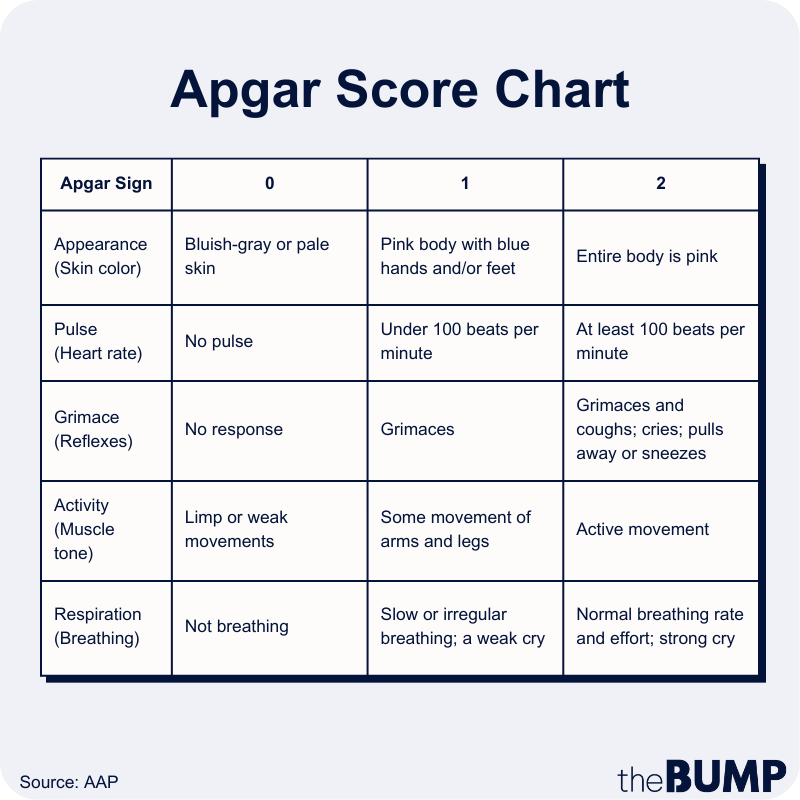What Does Baby’s Apgar Score Mean?
The first few minutes after baby is born can be a flurry of excitement and activity. A lot will be happening around you, but you’ll be so fixated on the wrinkly little cutie on your chest, you probably won’t even notice any poking or prodding. One thing that occurs right after baby makes their big debut: the Apgar test. It’s a quick medical evaluation that helps your provider determine how a newborn is adjusting to life outside the womb. But what does baby’s Apgar score mean? Read on to get the facts straight from experts.
The Apgar test is an assessment your medical team will use to evaluate how baby is adjusting to life outside the womb in the minutes after birth. The resulting Apgar score helps providers determine if any immediate medical interventions are necessary. “It’s simple, and it gives a general idea of how the newborn is [faring] in the very early period after they’re delivered,” adds Anna Penn, MD, the chief of the neonatology division at NewYork-Presbyterian/Morgan Stanley Children’s Hospital in New York City. “It’s a way to quickly communicate to everyone in the team how baby is doing,” adds S. Kam Lam, MD, a primary care pediatrician at the Cleveland Clinic in Lakewood, Ohio.
What does APGAR stand for?
The Apgar test was named for its creator, Virginia Apgar, an anesthesiologist and researcher at Columbia University. That said, it also serves as an acronym that breaks down the various factors the test evaluates:
- Appearance (skin color)
- Pulse (heart rate)
- Grimace response (reflexes)
- Activity (muscle tone)
- Respiration (breathing rate and effort
When baby is born and takes their first breath, their heart starts pumping oxygen-rich blood throughout the body. According to the Cleveland Clinic, this results in noticeable signals that the heart and lungs are working well. Baby’s skin color will change from pale to pink, and they’ll have a robust heart rate, strong muscle tone, active reflexes to certain stimuli and a steady rate of breathing.
While the Apgar test and score offers a helpful way for your healthcare team to ensure baby’s transition into the world, it has no bearing on their long-term health or well-being, notes the American Academy of Pediatrics (AAP).
According to the Cleveland Clinic, during the Apgar test, an OB or midwife will check baby’s skin color and muscle tone, listen to their heartbeat with a stethoscope, note their reflexes and monitor their cries. Your doctor rates each of these five categories to determine baby’s Apgar score.
Most of this can happen as baby lays on your chest for skin-on-skin time. “Parents may not realize that [their provider] is doing it, because a lot of this information you can get by looking at baby,” says Lam. For baby’s appearance and activity, practitioners check baby’s skin color and note whether their arms and legs are flexed or floppy, she says. For respiratory rate, they’ll assess whether baby seems to be breathing easily or struggling to get air.
Other measures may require a light physical workup. Your practitioner may check baby’s pulse with a stethoscope. They may assess baby’s grimace by stroking the palm of their little hand, which should curl around your finger. They’ll also note whether or not baby is crying, says Lam. “Baby should generally be pretty mad when they’re born,” she says.
When is the Apgar test given?
The Apgar test is typically given twice: one minute after baby is born, and then five minutes after birth. If baby scores below a 7, your practitioner may repeat the Apgar test every five minutes until they’re reassured by the number, says Penn—or they may determine that additional care is required.
How is the Apgar score calculated?
According to the Cleveland Clinic, baby’s Apgar score is calculated by rating each category from 0 to 2 points. Here’s how it works:
- Appearance: 0 points for blue or pale; 1 point for pink body but blue limbs; 2 points for pink body and limbs
- Pulse: 0 points for no pulse; 1 point for less than 100 beats per minute; 2 points for more than 100 beats per minute
- Grimace: 0 points for no reaction; 1 point for grimace or frowning; 2 points for crying, coughing or sneezing
- Activity: 0 points for limp or no movement; 1 point for some weak arm and leg movement; 2 points for strong movement and flexing of the arms and legs
- Respiration: 0 points for no breathing or crying; 1 point for a weak cry or whimper; 2 points for strong and loud cries
The test isn’t perfect—after all, it’s based on one healthcare provider’s momentary and subjective observations. Scores of baby’s activity, skin color and reflexes are based on opinion, meaning different practitioners may give slightly different scores to the same baby.
Want to get a better idea of how the Apgar score is determined? Check out this Apgar score chart which breaks it down by category.
The Apgar score measures a snapshot in time to help medical staff determine if baby needs a little extra help adjusting to life outside of the womb. It doesn’t predict baby’s health. The score is rated from 1 to 10, with 10 being the highest score. Anything over a 7 is considered reassuring.
You can always ask your practitioner for baby’s Apgar score, but it’s unlikely they’ll automatically share the results with you. “It may be confusing to parents if we give them this level of detail,” says. Lam.
What’s a normal Apgar score?
Most newborns have an Apgar score of 7, 8 or 9, which is considered normal, notes the AAP. (Few babies score 10, because most have blue hands and feet after birth.) Any score below 7 warrants monitoring and potential medical intervention.
“The absolute score isn’t what we’re worried about… Is the baby doing well during the period of transition to being out in the world? Is the baby having some trouble but looks like they’ll improve quickly or does the baby need a lot of help?” explains Penn.
What does a low Apgar score mean for baby?
Many babies have a slightly low score one minute after birth, often reflecting a perfectly normal transition from the womb to the outside world. “At one minute, the score is telling you just how baby is at the time they come out. At five minutes, it tells you how they’re transitioning,” says Penn. When scores improve between these two assessments, “that tells you that the baby had a stressful period, but that they’re doing much better now,” she adds.
A score between 4 and 7 means that baby may need some help, says Penn. Scores below 4 indicate that baby needs immediate medical intervention.
Babies born prematurely or at a lower birth weight tend to have lower Apgar scores on average. That doesn’t mean it’ll have any bearing on their health in the short- or long-term.
Baby may also be more likely to receive a low Apgar score if you had a difficult labor and delivery or an emergency c-section; if you had certain high-risk conditions during pregnancy, such as gestational diabetes or preeclampsia or if baby was born large for gestational age. If baby has any risk factors, your practitioner will prepare the medical team and equipment in advance of delivery, says Lam.
If your provider is concerned about baby’s Apgar score, they’ll explain the potential causes along with the care they’re providing. This usually first involves taking steps to improve baby’s breathing and heart rate, says Lam. It may mean clearing the airways by holding an oxygen mask over their face and rubbing them briskly with a towel. Again, most babies’ scores improve when the test is repeated at five minutes. “Often, that’s enough to have baby then start to make the transition on their own,” adds Penn.
A persistently low Apgar score may indicate a problem with baby’s heart or respiratory system that requires additional care, notes the American College of Obstetricians and Gynecologists (ACOG). To strengthen baby’s breathing and heartbeat, a provider may place a tube into baby’s windpipe or offer fluids and medications through an umbilical cord blood vessel. If baby’s score doesn’t improve, they may be moved to the neonatal intensive care unit (NICU) for additional monitoring and care. “Those are very rare cases,” says Penn. “Even if a score is very low, there are treatments available.”
Keep in mind that a low score doesn’t mean baby is unhealthy or that there are serious underlying issues. “What parents always want to know is, does my baby’s score predict whether they’re going to have brain damage? And the answer is absolutely not. For any individual baby, it’s not predictive,” reassures Penn.
The Apgar test and score simply offers healthcare providers a picture of baby’s health at a given moment in time. “It’s just one of the many tools that we have in the delivery process to help baby’s transition,” says Lam.
About the experts:
S. Kam Lam, MD, is a primary care pediatrician at the Cleveland Clinic in Lakewood, Ohio. She earned her medical degree from the George Washington University School of Medicine and Health Sciences.
Anna Penn, MD, is the chief of the neonatology division at NewYork-Presbyterian/Morgan Stanley Children’s Hospital in New York City. She earned her medical and doctorate degrees from Stanford University School of Medicine in Santa Clara County, California.
Please note: The Bump and the materials and information it contains are not intended to, and do not constitute, medical or other health advice or diagnosis and should not be used as such. You should always consult with a qualified physician or health professional about your specific circumstances.
Plus, more from The Bump:
Navigate forward to interact with the calendar and select a date. Press the question mark key to get the keyboard shortcuts for changing dates.





















































